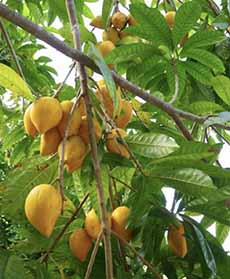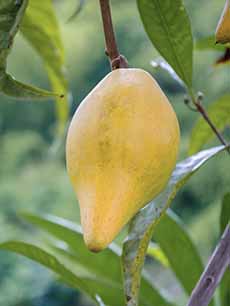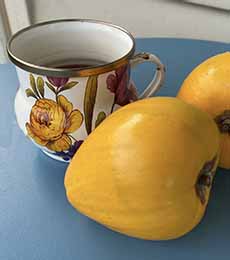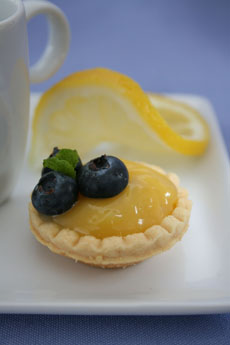Eggfruit a.k.a. Canistel, A Fruit For National Egg Month
|
|
May is National Egg Month, and some eggs really do grow on trees, says our colleague Hannah Kaminsky of Bittersweet Blog. But they’re not eggs from chickens, ducks, geese, ostrich, or any other bird—or roe from fish, for that matter. Rather, they’re eggfruit (or eggfruits), otherwise known as canistel. Still relatively unknown beyond tropical climates, these teardrop-shaped drupes* originated in Central America and have spread to the U.S., now grown in Florida, Hawaii, and Southern California. So as we come to the end of National Egg Month, allow us to introduce you to eggfruit. We have ways to eat them and a recipe for eggfruit curd below, but first: The pulp of the eggfruit/canistel fruit (Pouteria campechiana), also known as yellow sapote and cupcake fruit, has a dense, cake-like texture similar to the yolk of a hard-boiled egg. Eggfruit do not, however, taste anything like eggs. The flavor of the fruit is delicious, sweet, and somewhat like that of a candied sweet potato. The flavor is rich and is reminiscent of egg custard. The best varieties have a creamy, mousse-like texture. The bright-orange fruit is naturally low in fat. Canistel varieties come in many different shapes and sizes. There are long and skinny varieties, short and fat varieties, varieties as large as your head, as small as a tangerine, and everything in between. Cut through the thin skin to reveal a hard pit (or up to six pits—be careful with your teeth if you decide to bite into it) much like that of an avocado. The pit is surrounded by creamy, slightly crumbly flesh with a downright uncanny resemblance to hard-boiled egg yolks. It’s certainly an unusual experience, says Hannah. “There’s nothing else quite like it in the animal or vegetable kingdom.” Well…it does have relatives. Eggfruit is a member of the Sapote family, many species of which produce edible fruits, including sapodilla, star-apple, shea nuts (used to make shea butter), and the nuts of the argan tree, used to make argan oil. In its own genus, Pouteria, are “siblings” abiu, lúcuma, and mamey sapote. So, while Pouteria campechiana may be part of a family that’s exotic to Americans, it’s a valuable source of food in other parts of the world. Canistel is an evergreen tree native to Central America and northern South America. It’s cultivated in Belize, El Salvador, Guatemala, and southern Mexico. Showing its popularity, it’s cultivated in other countries around the world, including Australia, Brazil, Cambodia, Costa Rica, Dominican Republic, India, Indonesia, Nigeria, Philippines, Sri Lanka, U.S., and Vietnam. The temptation to draw comparisons to conventional eggs is irresistible. Such gorgeous golden meat, rich in beta-carotene, is good for more than just boosting eyesight and immunity. You can buy eggfruit online, you can buy eggfruit trees to grow your own backyard (if you live in warmer climate zones), and you can even buy seeds to sprout your own trees. Eggfruit may be enjoyed from breakfast through dessert. For breakfast: Smooth, spreadable, or spoonable like custard, you can spread it on toast, or use it as a topping for French toast, pancakes, and waffles. For a snack: As a hand fruit; simply seasoned with salt, pepper, and a squeeze of lime; in a smoothie. For dessert: Purée it as a topping or sauce for pound cake, ice cream or sorbet; a pudding; a filling for cupcakes and cookies; a fruit curd (a recipe follows); a mixed fruit salad. Hannah Kaminsky’s recipe substitutes eggfruit for the conventional citrus curd. You can make any curd with this recipe: grapefruit, lemon, lime, orange, strawberry, yuzu, etc. Smooth, spreadable, or spoonable like custard, this rich lemon curd is an ideal introduction to eggfruit. You’ll fall in love after one batch, assures Hannah. If you can, she says, stock up on eggfruit whenever you see them, since they’ll go fast once you taste just how versatile they are. You’ll typically find unripe eggfruit in the store that’s still hard and slightly green. Let it sit on the counter to ripen. It could take as long as 10 to 14 days, so be patient. Unripe eggfruit is incredibly astringent and bitter—not good to eat. When ripe, it should be soft but not mushy, yielding easily to a knife. Then, it can be stored whole for 1 to 2 months in the fridge, or mashed and frozen for 6 to 8 months. Cook time is 9 minutes, and additional time is 2 minutes. For a variation, you can add up to 1/2 cup of seedless fruit purée, like strawberry, raspberry, or peach. 1. PEEL and pit the eggfruit, placing the flesh in a blender. Add all the remaining ingredients and thoroughly purée, pausing to scrape down the sides of the canister as needed. 2. TRANSFER the mixture to a medium-sized microwave†-safe bowl. Microwave on 100% power‡ for 4-1/2 minutes, uncovered. Whisk vigorously until smooth and microwave again on 100% power for 4 1/2 minutes more. The curd should be thick and glossy. 3. WHISK vigorously for another minute to make sure there are no lumps. Transfer to a glass jar, let cool completely and store in the fridge. Enjoy chilled. *In botany, a drupe (or stone fruit) is an indehiscent fruit in which an outer fleshy part (exocarp, or skin, and mesocarp, or flesh) surrounds a single shell (the pit or stone of hardened endocarp with a seed (kernel) inside. Flowering plants that produce drupes include cashew, coffee, jujube, mango, olive, most palms (including açaí, date, sabal, coconut, and oil palms), pistachio, white sapote, and all members of the genus Prunus, the “stone fruits,” that include the almond, apricot, cherry, damson, peach, nectarine, and plum. [Here’s more about drupes. |
|
|
†If you don’t have a microwave, you can cook the curd over the stove in a medium saucepan. Just stir gently and continuously so it doesn’t stick or burn on the bottom. ‡This recipe was tested on a 1,000-watt microwave; timing may vary if you have a more or less powerful model. Always keep a close eye on the mixture while cooking. |
||







